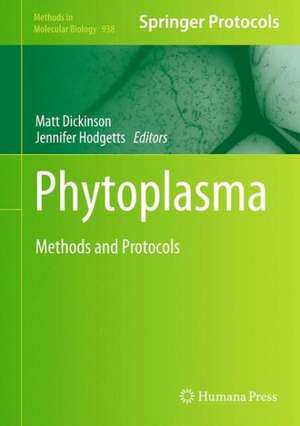Phytoplasma: Methods and Protocols: Methods in Molecular Biology, cartea 938
Editat de Matt Dickinson, Jennifer Hodgettsen Limba Engleză Hardback – 18 sep 2012
Authoritative and easily accessible, Phytoplasmas: Methods and Protocols serves as an ideal guide to plant pathologists and molecular biologists aiming to set up a diagnostics facility for identifying the presence of these pathogens in plants or their insect vectors.
| Toate formatele și edițiile | Preț | Express |
|---|---|---|
| Paperback (1) | 708.93 lei 6-8 săpt. | |
| Humana Press Inc. – 23 aug 2016 | 708.93 lei 6-8 săpt. | |
| Hardback (1) | 963.15 lei 6-8 săpt. | |
| Humana Press Inc. – 18 sep 2012 | 963.15 lei 6-8 săpt. |
Din seria Methods in Molecular Biology
- 9%
 Preț: 791.63 lei
Preț: 791.63 lei - 23%
 Preț: 598.58 lei
Preț: 598.58 lei - 20%
 Preț: 882.98 lei
Preț: 882.98 lei -
 Preț: 252.05 lei
Preț: 252.05 lei - 5%
 Preț: 802.70 lei
Preț: 802.70 lei - 5%
 Preț: 729.61 lei
Preț: 729.61 lei - 5%
 Preț: 731.43 lei
Preț: 731.43 lei - 5%
 Preț: 741.30 lei
Preț: 741.30 lei - 5%
 Preț: 747.16 lei
Preț: 747.16 lei - 15%
 Preț: 663.45 lei
Preț: 663.45 lei - 18%
 Preț: 1025.34 lei
Preț: 1025.34 lei - 5%
 Preț: 734.57 lei
Preț: 734.57 lei - 18%
 Preț: 914.20 lei
Preț: 914.20 lei - 15%
 Preț: 664.61 lei
Preț: 664.61 lei - 15%
 Preț: 654.12 lei
Preț: 654.12 lei - 18%
 Preț: 1414.74 lei
Preț: 1414.74 lei - 5%
 Preț: 742.60 lei
Preț: 742.60 lei - 20%
 Preț: 821.65 lei
Preț: 821.65 lei - 18%
 Preț: 972.30 lei
Preț: 972.30 lei - 15%
 Preț: 660.49 lei
Preț: 660.49 lei - 5%
 Preț: 738.41 lei
Preț: 738.41 lei - 18%
 Preț: 984.92 lei
Preț: 984.92 lei - 5%
 Preț: 733.29 lei
Preț: 733.29 lei -
 Preț: 392.60 lei
Preț: 392.60 lei - 5%
 Preț: 746.26 lei
Preț: 746.26 lei - 18%
 Preț: 962.66 lei
Preț: 962.66 lei - 23%
 Preț: 860.22 lei
Preț: 860.22 lei - 15%
 Preț: 652.64 lei
Preț: 652.64 lei - 5%
 Preț: 1055.50 lei
Preț: 1055.50 lei - 23%
 Preț: 883.87 lei
Preț: 883.87 lei - 19%
 Preț: 491.89 lei
Preț: 491.89 lei - 5%
 Preț: 1038.86 lei
Preț: 1038.86 lei - 5%
 Preț: 524.16 lei
Preț: 524.16 lei - 18%
 Preț: 2122.34 lei
Preț: 2122.34 lei - 5%
 Preț: 1299.23 lei
Preț: 1299.23 lei - 5%
 Preț: 1339.12 lei
Preț: 1339.12 lei - 18%
 Preț: 1390.26 lei
Preț: 1390.26 lei - 18%
 Preț: 1395.63 lei
Preț: 1395.63 lei - 18%
 Preț: 1129.65 lei
Preț: 1129.65 lei - 18%
 Preț: 1408.26 lei
Preț: 1408.26 lei - 18%
 Preț: 1124.92 lei
Preț: 1124.92 lei - 18%
 Preț: 966.27 lei
Preț: 966.27 lei - 5%
 Preț: 1299.99 lei
Preț: 1299.99 lei - 5%
 Preț: 1108.51 lei
Preț: 1108.51 lei - 5%
 Preț: 983.76 lei
Preț: 983.76 lei - 5%
 Preț: 728.16 lei
Preț: 728.16 lei - 18%
 Preț: 1118.62 lei
Preț: 1118.62 lei - 18%
 Preț: 955.25 lei
Preț: 955.25 lei - 5%
 Preț: 1035.62 lei
Preț: 1035.62 lei - 18%
 Preț: 1400.35 lei
Preț: 1400.35 lei
Preț: 963.15 lei
Preț vechi: 1174.58 lei
-18% Nou
Puncte Express: 1445
Preț estimativ în valută:
184.36€ • 200.32$ • 154.96£
184.36€ • 200.32$ • 154.96£
Carte tipărită la comandă
Livrare economică 21 aprilie-05 mai
Preluare comenzi: 021 569.72.76
Specificații
ISBN-13: 9781627030885
ISBN-10: 1627030883
Pagini: 434
Ilustrații: XIII, 421 p.
Dimensiuni: 178 x 254 x 30 mm
Greutate: 0.95 kg
Ediția:2013
Editura: Humana Press Inc.
Colecția Humana
Seria Methods in Molecular Biology
Locul publicării:Totowa, NJ, United States
ISBN-10: 1627030883
Pagini: 434
Ilustrații: XIII, 421 p.
Dimensiuni: 178 x 254 x 30 mm
Greutate: 0.95 kg
Ediția:2013
Editura: Humana Press Inc.
Colecția Humana
Seria Methods in Molecular Biology
Locul publicării:Totowa, NJ, United States
Public țintă
Professional/practitionerCuprins
The Phytoplasmas - An Introduction.- Techniques for the Maintenance and Propagation of Phytoplasmas in Glasshouse Collections of Catharanthus roseus.- Micropropagation and Maintenance of Phytoplasmas in Tissue Culture.- Dodder Transmission of Phytoplasmas.- Insect Maintenance and Transmission.- Capturing Insect Vectors of Phytoplasmas.- Insect Vector Transmission Assays.- Molecular Identification of Phytoplasma Vector Species.- Dienes’ Staining and Light Microscopy for Phytoplasma Visualization.- DAPI Staining and Fluorescence Microscopy Techniques for Phytoplasmas.- Visualisation of Phytoplasmas using Electron Microscopy.- Automated DNA Extraction for Large Numbers of Plant Samples.- DNA Extraction from Arborescent Monocots and How To Deal With Other Challenging Hosts.- Nested PCR and RFLP Analysis Based on the 16S rRNA Gene.- PCR and RFLP Analyses Based on the Ribosomal Protein Operon.- Tuf and secY PCR Amplification and Genotyping of Phytoplasmas.- PCR Analysis of Phytoplasmas Based on the secA Gene.- Single-Strand Conformation Polymorphism Analysis for Differentiating Phytoplasma Strains.- Microarrays for Universal Detection and Identification of Phytoplasmas.- T-RFLP for Detection and Identification of Phytoplasmas in Plants.- Real-Time PCR for Universal Phytoplasma Detection and Quantification.- A Real-Time PCR Detection System for the Bois Noir and Flavescence Dorée Phytoplasmas and Quantification of the Target DNA.- Real-Time PCR for Specific Detection of Three Phytoplasmas from the Apple Proliferation Group.- Reverse Transcription-PCR for Phytoplasma Detection Utilizing Crude Sap Extractions.- In-Field Diagnostics Using Loop-Mediated Isothermal Amplification (LAMP).- DNA Bar-Coding for Phytoplasma Identification.- Phylogenetic Analyses of Phytoplasmas Based on Whole-Genome Comparison.- The iPhyClassifier, An Interactive Online Tool for Phytoplasma Classification and Taxonomic Assignment.- Phytoplasma Proteomic Analysis.- Preparation ofPhytoplasma Membrane Recombinant Proteins.- Phytoplasma Plasmid DNA Extraction.- Caesium Chloride-Bisbenzimide Gradients for Separation of Phytoplasma and Plant DNA.- Pulsed-Field Gel Elecrophoresis for Isolation of Full-Length Phytoplasma Chromosomes From Plants.- Mapping the Phytoplasma Chromosome.
Textul de pe ultima copertă
Phytoplasmas are a group of bacteria that are capable of multiplying and causing severe diseases in a wide range of plant species and are transported between plants by insect vectors in which the bacteria can also multiply. Phytoplasmas can cause serious and devastating problems for crop plants, especially in developing countries. In Phytoplasmas: Methods and Protocols experts in the field cover topics pertinent to scientists intending to develop a research program on phytoplasmas. The volume opens with an introductory chapter on the importance of phytoplasma diseases, followed by methods for detection and diagnosis as well as techniques for separating and classifying the phytoplasmas into their different taxonomic groups and subgroups. The final chapters cover methods for separating phytoplasma genomic and plasmid DNA from plant DNA for whole genome sequencing. Written in the successful Methods in Molecular Biology™ series format, chapters include introductions to their respective topics, lists of the necessary materials and reagents, step-by-step, readily reproducible protocols, and notes on troubleshooting and avoiding known pitfalls.
Authoritative and easily accessible, Phytoplasmas: Methods and Protocols serves as an ideal guide to plant pathologists and molecular biologists aiming to set up a diagnostics facility for identifying the presence of these pathogens in plants or their insect vectors.
Authoritative and easily accessible, Phytoplasmas: Methods and Protocols serves as an ideal guide to plant pathologists and molecular biologists aiming to set up a diagnostics facility for identifying the presence of these pathogens in plants or their insect vectors.
Caracteristici
Includes cutting-edge methods and protocols Provides step-by-step detail essential for reproducible results Contains key notes and implementation advice from the experts Includes supplementary material: sn.pub/extras








